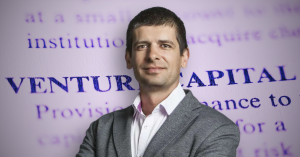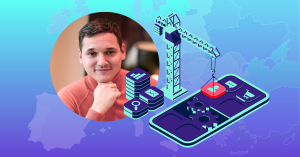Starting a business is like embarking on a thrilling adventure, full of excitement and boundless opportunities. But just like any great adventure, it’s not without its challenges. In fact, statistics show that the majority of startups don’t make it past their first year.
So where do most startups stumble in the early days? The Recursive caught up with Vesko Kolev, Founder and CEO of icanpreneur, the digital accelerator SaaS platform, and Nick Gospodinov, first-time founder and CEO of Enbank, the plug-and-play platform for account-to-account payments. Through their experience, they have identified 5 common mistakes made by first-time founders that can hinder the success of a startup.
From taking too long to launch to team disharmony, the list of potential pitfalls is not short. If you’re thinking of starting a business or are a startup founder, read on to learn how to avoid these startup mistakes and chart a course to success.
Mistake #1: Underestimating the importance of having a passion for problem-solving
As a first-time founder, it’s easy to fall into the trap of picking a problem that seems like it needs a solution, but that you have no real connection to. This can result in a lack of motivation and ultimately, failure.
“Fall in love with the problem rather than the product” is great advice. The challenge with it is that on its own it is not very actionable. I believe that problems are not the right unit of analysis. Customers are also not the right unit of analysis. The right unit of analysis is the combination of customers and the progress they need or want to make in given circumstances. The problems in that context are the impediments that stay between customers and their desired state of being. That’s why my advice is for entrepreneurs to fall in love with the progress that a specific group of customers aims to make and make sure it is in a space that they deeply care about,” Vesko Kolev highlights.
The key is to focus on the problem, not just the solution. Successful first-time founders are those who are most passionate about the problem they’re solving. They have a problem-centric mindset that drives them towards building creative solutions and keeps them from giving up when those solutions fail. By tying your attention to your product users, you can ensure that you’re building something that truly meets their needs.
“When my co-founder Alex Bonin and I started Enbank back in 2022, we launched it as an app in the e-commerce payments space. Enbank was born out of my frustration with company invoice management back at the time I was working at Kraken. In the beginning, we got hyped about becoming the go-to payment platform for e-commerce in Bulgaria and Europe. It sounded very attractive to be the coolest brand in the payment space. However, we kept hearing from our customers that they find it valuable to have all of their payment links in one place. So, that’s how we ended up doing a pivot and are currently developing an account-to-account platform that covers a wide range of SMEs’ business payment needs,” Nick Gospodinov explains.
Mistake #2: Not putting effort into building a strong user base
“The only necessary and sufficient condition that transforms an initiative into a business is paying customers. The question is how to start selling something that is not ready. Early adopters are a special breed of customers that are crazy enough to give you money for your not-ready-yet offering. Finding these first customers is the first signal for you, your team, and current and future investors that your endeavor has the potential to become a business,” Vesko Kolev advises.
The lesson here is clear: building a startup requires too much self-sacrifice to spend your time solving a problem for people you don’t care about. To avoid this mistake, make sure you’re as passionate about the users as you are about the problem you’re solving. Your understanding of and commitment to the problem and the users should remain your bedrock. That way, your solution will naturally change and adapt to new information about your users.
“Founders need to interview early adopters as early as possible before even working on the product to understand what problems exactly do they have. We acquired our 40-50 clients very early on and our goal now is to make them as engaged as possible. In order to build a strong base of product ambassadors, you need to turn your first 50 to 100 clients into your best friends. Create a product newsletter or a WhatsApp group. But don’t just give them informational product updates. Instead, actively seek their real-time feedback and use it for rapid iterations,” Nick Gospodinov shares.
Mistake #3: Neglecting strong co-founder relationships
Poor relationships between co-founders can be the downfall of a startup. Whether it’s choosing a co-founder you don’t know well or not being fully transparent with them, these mistakes can lead to disaster. Studies point out that 23% of startup failures can be attributed to team-related problems, including conflicts between co-founders.
“Being friends or colleagues is not the same as being co-founders. The difference between a startup and a scaleup/enterprise is that a startup needs to discover a working business model while a later-stage company is focused on executing an already existing business model. In other words, the startup stage is all about hypothesizing, testing, and discovering, while scaleups/enterprises are primarily focused on clear roadmap execution and eliminating risks. That makes startups a completely different breed of animal where ambiguity is the norm and a combination of a growth mindset and a leap of faith are critical requirements. Self-doubt is not an option. Team confidence (not to be confused with arrogance) is essential,” Vesko Kolev points out.
One way to avoid conflicts is to establish roles and responsibilities early on in the startup’s development. This can help to minimize misunderstandings and ensure that each co-founder understands their specific duties and areas of responsibility.
“It’s crucial to work with a person who not only has a complementary skill set but who also has a complementary character and shares the same passion and work dynamic. Alex and I met while studying at King’s College London and became great friends around our shared passion for technology. Before deciding to work on Enbank together, we did quite a few projects and hackathons together in robotics, fintech, and AI, and even worked together at Kraken. So for us, the fit was obvious before the start,” Nick Gospodinov tells me.
Mistake #4: Taking too long to launch your product
“Acting fast is the only advantage that you have as a startup founder. We have established a process based on weekly hypotheses on product, marketing, and sales, which we test and immediately validate or change, and move forward,” Nick points out.
Speed matters in the startup world. Most first-time founders make the mistake of delaying the launch of their product or idea because they think they’re not ready. However, excessive perfectionism sometimes leads to time wastage in creating a product that your customers may not need.
“Creative thinking and innovation are very often unleashed when there is a scarcity of resources. Launching your product as soon as possible is an important goal, especially when product-led growth is the primary measurement of success for startups these days. However, whatever you are launching should be initially targeted to early adopters (not to the mainstream) customers and should make one thing clear and visible – how your offering is or will be going to enable these customers to make the progress they need or want to make,” Vesko Kolev says.
The truth is, the day you launch is not as significant to your users as it is to you. There’s no brand until you build it and put it out there. And until you get your product in front of customers, you can’t validate whether it’s solving your problem. If you’re not too sure about your product or idea stance, recruiting beta users is the next best thing. By doing this, you can get valuable feedback that will help shape your final product.
Mistake #5: Inability to balance growth and fundraising
The key is to balance speed with the right match. Instead of going to potential investors without any apparent business blueprint, first-time founders can try to start operations by bootstrapping. This approach will allow you to develop your product and prove that users are actively using it.
“Before product/market fit, startups focus is to discover a working business model. After product/market fit the goal becomes scaling. That means that in the pre-product/market fit phase, startups are focused on learning and after it – on growth. In contrast investors in general are interested in growth. That means that the best time to raise money is after product/market fit as this is the time when the goals of the founders and investors are completely aligned. However, that is often not possible as founders need money to be able to get their startup off the ground. That’s why finding the right investors for the pre-product/market fit that are well aware of the goals of that stage is absolutely essential for your success. Angels or funds with a history of investing in the pre-product/market fit stage will be the way to balance growth and fundraising easily,” Vesko Kolev shares.
As a first-time founder, you might be tempted to rush to raise venture capital without clear goals. But the truth is, you can’t do both simultaneously. Excessive fundraising can actually harm startups by causing them to focus too much on short-term growth and neglect long-term sustainability.
“Currently, we are in the process of fundraising and I am still navigating the waters of building a product and trying to secure capital for growth. Recently, I realized that I haven’t talked with one of my teammates in two weeks. This made me realize the need to put some frameworks into my daily tasks. Now, I am trying to devote around 80% of my time to fundraising, while the other 20% I use to just be there for my team, communicate with them, and ensure that we all have the same vision and direction for the immediate next steps,” Nick concludes.







